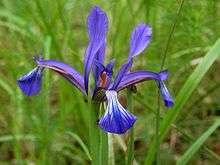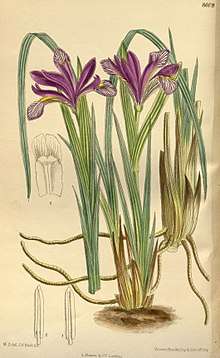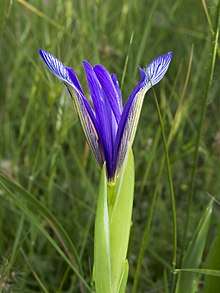Iris sintenisii
Iris sintenisii is a species in the genus Iris, it is also in the subgenus Limniris and in series Spuriae, with tall thin stems, violet-blue flowers and long grass-like leaves. It is a rhizomatous perennial plant, from grass meadows (including steppe) parts of Europe, Russia, and Turkey. It is cultivated as an ornamental plant in temperate regions.
| Iris sintenisii | |
|---|---|
 | |
| Iris sintenisii flower in Bulgaria | |
| Scientific classification | |
| Kingdom: | Plantae |
| Clade: | Tracheophytes |
| Clade: | Angiosperms |
| Clade: | Monocots |
| Order: | Asparagales |
| Family: | Iridaceae |
| Genus: | Iris |
| Subgenus: | Iris subg. Limniris |
| Section: | Iris sect. Limniris |
| Series: | Iris ser. Spuriae |
| Species: | I. sintenisii |
| Binomial name | |
| Iris sintenisii Janka | |
| Synonyms[1] | |
| |
Description
Iris sintenisii is intermediate in appearance and form, between Iris graminea and a small Iris spuria.[2]
It has thin (or slender),[3][4] wiry (or hard), short rhizomes.[5][6][7] That are covered with the brown, fibrous remains of the last seasons leaves.[4][6][7]
Over time it forms many branches to create a tight clumps or tussocks.[8][9][10]
It has linear, glaucous green to dark green, rigid, acuminate (tapering to a long point), grass-like leaves.[11][12][13] They are often described as evergreen.[14][15][16] They have clear pronounced veins.[3][4] They can grow up to between 10–50 cm (4–20 in) long,[17] and 0.3–0.5 cm wide.[18][19][20] The leaves often exceed the height of the flower stems.[21][22][23]
Iris sintenisii is smaller than Iris graminea.[24] It has cylindrical or slightly compressed, unbranched stems.[7][17][25] They can grow up to between 10–40 cm (4–16 in) long.[26][27][28]
The stems have 2–3,[6] green spathes, (leaves of the flower bud), that are 3.5–7.5 cm long.[4][6][25] The leaves are all keeled.[6][7][25] The inner leaves are slightly longer the outer leaves.[6]
The stems or peduncle hold 1 or 2,[20][21][23] terminal (top of stem) flowers,[6][21] between late spring and summer,[14][15][27] between June and July.[19][28][29]
The flowers are similar in form to Iris graminea but in different shades of colour.[24] The flowers are not scented,[18][25] and can be up 5–6 cm (2–2 in) in diameter,[20][18][30] and come in shades of violet-blue,[2][10][31] blue-purple,[21][30][12] blue,[29][16][32] purple,[3][27][33] and violet.[20][13]
It has 2 pairs of petals, 3 large sepals (outer petals), known as the 'falls' and 3 inner, smaller petals (or tepals, known as the 'standards'.[9] The slender falls are slightly panduriform (shaped like a fiddle).[6] They have a rounded or ovate/elliptic blade, measuring 1.3–1.4 cm long and 0.9–1.3 cm wide.[4][7][25] Then they have a narrowing before a long oval haft (connecting to the stem), measuring 2.5–3 cm long and 0.3–0.5 cm wide.[4][7][21] The haft is veined with red-purple.[6] They are white or cream, heavily veined violet-blue or purple.[30][11][12]
It has single coloured (violet-blue to blue-purple),[21] upright standards that are oblanceolate and 3–4 cm long and 0.4–0.5 cm wide.[7][9][23]
It has single coloured (violet-blue to blue-purple), style branches, that are 2.6–2.8 cm long and 0.5–0.6 cm wide, with recurved lobes.[4][6][7] It has a small slender ovary 1–2 cm long, with a slender beak.[4][25] It also has small, triangular crests.[6]
This iris is uniquely pollinated by ants, as the flowers secrete nectar at the base of the petals.[17][11]
After the iris has flowered, it produces an oblong, seed capsule,[3][5] 1.5 cm long and 1 cm wide.[4] It also has a slender beak appendage up to 2 cm long.[4]
Biochemistry
As most irises are diploid, having two sets of chromosomes. This can be used to identify hybrids and classification of groupings.[9] It has been counted several times; 2n=16, ex Randolph and Mitra 1956, Lenz, Bulletin of the American Iris Society169: 55. 1963; 2n=16, 32 Simonet 1934; 2n=16, Lenz 1963 and 2n=16, Popova, M., & I. Cesmedziev, (1975 & 1976).[32] Normally the chromosome count is recorded as 2n=16, 32.[6][17][31]
In 2013, a study was carried out on the morphological and anatomical properties of Iris iberica subsp. elegantissima and Iris sintenisii were investigated. The cross-sections of root, scape and leaf parts of the plant were examined. During the anatomical studies, the wall thickenings of the endodermal cells were found to be three-sided. Leaf features, such as papillae, metaxylem number in the root and arrangement of vascular bundles can be used as distinguishing characters for the Iris species. [4]
Taxonomy

It is known as Sintenis-Schwertlilie in Germany.[34]
It has the common name of Sintenisa iris.[22][35] The Latin specific epithet sintenisii refers to Paul Sintenis, a botanical collector.[2]
Specimens were first collected by Sintenis from the Dobrudja district, (of Bulgaria) on the western coast of the Black Sea, to the south of the mouth of the Danube.[21] It was then published and described by Victor Janka von Bules in 'Természetrajzi Füz' (printed in Budapest) Vol.1 on page 244 in 1877.[36][37]
In 1994, it was given Award of Garden Merit (AGM).[19][30] It was then verified by United States Department of Agriculture Agricultural Research Service on 4 April 2003,[37] and is an accepted name by the RHS.[38]
Distribution and habitat
Iris sintenisii is native to temperate regions of Asia Minor,[3][5][13] and eastern Europe and south eastern Europe.[37][7][20]
Range
It is found in Turkey (Asia Minor),[6][7][39] Within Europe, it is found in Albania,[25][31][37] Bulgaria,[5][31][26] Romania,[5][26][37] and parts of former Yugoslavia,[18][31][26]
It is also found within the south western parts of the Russian Federation or USSR.[6][7][19] Also found in North Macedonia.[40][41]
One reference mentions France and Ukraine,[17] but these could be naturalized populations.
Habitat
Iris sintenisii grows in dry grass meadows (including steppes),[5][20][9] on scrubland,[20][9][18] and at the edges of forests.[5][20]
It can be found at altitudes of between 900-1500m above sea level.[5][18][28]
It can though be difficult to spot within meadows, after flowering as the leaves are very grass-like.[11]
Cultivation
It is hardy to between USDA Zone 5a (−28.8 °C (−20 °F)) to USDA Zone 9b (−3.8 °C (25 °F)).[15] It is also in European Zone H2.[7] It can tolerate temperatures as low as −18 °C.[17][33][18] It is hardy in the UK,[19] although within Russia, it is not hardy in St Petersburg, but thrives in the Botanical Garden of Stavropol.[13][22]
It prefers to grow in well-drained soils,[33][8][29] that do not dry out during the summer.[6] The shallow roots do not like intense summer heat, which dries out the soil.[6][9][29] They are tolerate of soils containing limestone.[17] They can grow in neutral to alkaline soils (with a pH level of between 6.6 and 8.5).[15]
The like to grow in positions in full sun or partial shade.[8][18][29]
During the summer or growing season, the iris requires lots of moisture to bloom.[6][14] But care must be taken not to over-water.[15]
They can be grown in a rock garden or rockery,[3][17][10] or in the front of a flower border.[6] They are also suitable for use growing in trough or sink gardens (using old large disused sinks).[10][23]
Care must be taken when weeding during the autumn and early spring, as the leaves are very similar to grass.[18]
Propagation

Irisi sintenisii can be propagated by division or by seed growing.[15] Since, like many other spuria irises, it resents root disturbance,[6] also the roots are very vulnerable to damage during clump division.[14] It should be propagated by seed.[6] The seeds can be collected from the capsules, when ripe and should be sown direct into clear soil, outdoors or into pots.[6][15] The young seedlings can then be transplanted either during the beginning of spring or at the start of autumn (fall).[6][14] They should be plant with a planting distance of 40 cm, as they do not like root competition.[29] This species, which is pollinated by ants, is closely related to Iris graminea.[11]
Toxicity
Like many other irises, most parts of the plant are poisonous (rhizome and leaves), if mistakenly ingested can cause stomach pains and vomiting. Also handling the plant may cause a skin irritation or an allergic reaction.[15]
Hybrids and cultivars
For a long while Iris brandzae was considered a subspecies of Iris sintenisii, but it is now classified as a separate species.[42]
Other known cultivars are 'Sintenissii Uromovi' and 'Topae'.[32]
References
- "Iris sintenisii Janka is an accepted name". theplantlist.org (The Plant List). 23 March 2013. Retrieved 4 February 2015.
- Dykes, William (2009). "Handbook of Garden Irises" (PDF). beardlessiris.org (The Group for Beardless Irises). Retrieved 1 November 2014.
- "COLLECTION IRIS natural flora, Introdutciruemyh in the Botanical Garden Samara State University" (PDF). .ssc.smr.ru (Samara State University). 2007. Retrieved 12 February 2015.
- Akyol, Yurdanur; Yetişen, Kadriye; Özdemir, Canan (2 June 2013). "Morphological and anatomical studies of Iris iberica subsp. elegantissima and Iris sintenisii (Iridaceae) from Turkey" (PDF). Phytologia Balcanica. 20 (1): 71–77. Retrieved 23 February 2015.
- Rencova, Eva (25 May 2010). "Iris sintenisii Janka". botany.cz. Retrieved 20 February 2015.
- British Iris Society (1997) A Guide to Species Irises: Their Identification and Cultivation, p. 187, at Google Books
- James Cullen, Sabina G. Knees and H. Suzanne Cubey (Editors) The European Garden Flora Flowering Plants: A Manual for the Identification(2011), p. 348, at Google Books
- "Iris sintenisii, Asia Minor Dwarf – steppe Iris". zauberstaude.de. Retrieved 23 February 2015.
- Austin, Claire (2005). Irises: A Gardener's Encyclopedia. Timber Press, Incorporated. ISBN 978-0881927306. OL 8176432M.}
- "Iris sintenisii dwarf". wrightmanalpines.com. Retrieved 24 February 2015.
- "Iris sintenisii". plant-world-seeds.com. Retrieved 23 February 2015.
- Christopher Brickel (Editor) RHS Encyclopedia of Plants and Flowers (5th Edition 2010) , p. 613, at Google Books
- "Spuria iris". flowerlib.ru. Retrieved 12 February 2015.
- "Spuria Irises". herbs2000. Retrieved 14 January 2015.
- "PlantFiles: Spuria Iris Iris sintenisii". davesgarden.com. Retrieved 23 February 2015.
- "Iris sintenisii". jardin-nature.net. Retrieved 24 February 2015.
- "Chapter II iris clump and other (part3)". irisbotanique.over-blog.com. Retrieved 17 February 2015.
- Phillips, Roger; Rix, Martyn (1991). Perennials Vol. 1. Pan Books Ltd. p. 216. ISBN 9780330327749.
- "Iris sintenisii". rareplants.co.uk. Archived from the original on 27 February 2015. Retrieved 23 February 2015.
- "Iris sintenisii". encyclopaedia.alpinegardensociety.net. Retrieved 20 February 2015.
- Dykes, William. "Dykes on Iris" (PDF). beardlessiris.org (The Group for Beardless Irises). Retrieved 21 November 2014.
- "Irises section Ksiridion or Spur-iris sredneroslye". flower.onego.ru. Retrieved 12 February 2015.
- Cassidy, George E.; Linnegar, Sidney (1987). Growing Irises (Revised ed.). Bromley: Christopher Helm. ISBN 0-88192-089-4.
- "The Small Spurias". kcis.org. Retrieved 20 February 2015.
- Thomas Gaskell Tutin (Editor) Flora Europaea, Volume 5 (1980) , p. 89, at Google Books
- Kramb, D. (2 October 2004). "Iris sintenisii". signa.org (Species Iris Group of North America). Retrieved 23 February 2015.
- Stebbings, Geoff (1997). The Gardener's Guide to Growing Irises. Newton Abbot: David and Charles. p. 61. ISBN 0715305395.
- "Iris sintenisii". bgflora.net. Retrieved 24 February 2015.
- "Iris sintenisii". jardindumorvan.com. Retrieved 24 February 2015.
- "Search for AGM plants". www.rhs.org.uk. Retrieved 23 February 2015.
- "Iris summary" (PDF). pacificbulbsociety.org. 14 April 2014. Retrieved 23 November 2014.
- Laurin, Terry (19 September 2014). "(SPEC) Iris sintenisii Janka". wiki.irises.org (American Iris Society). Retrieved 4 February 2015.
- "Iris sintenisii". delafleuraumiel.com. Retrieved 23 February 2015.
- "Pflanzen". delta-tours.de. Retrieved 24 February 2015.
- "Iris fancy". atlas-roslin.pl. Retrieved 24 February 2015.
- "IIridaceae Iris sintenisii Janka". ipni.org (International Plant Names Index). Retrieved 4 February 2015.
- "Iris sintenisii". Germplasm Resources Information Network (GRIN). Agricultural Research Service (ARS), United States Department of Agriculture (USDA). Retrieved 23 February 2015.
- "Iris sintenisii". www.rhs.org.uk. Retrieved 23 February 2015.
- "Iris sintenisii". tubives.com (Turkey's Plants Data Service). Retrieved 24 February 2015.
- Vlado Matevski, Andraž Èarni, Oliver Avramoski, Nina Juvan, Mitko Kostadinovski, Petra Košir, Andrej Paušiè, Urban Šilc Forest Vegetation of Galièica Mountain Range in Macedonia , p. 152, at Google Books
- Vlado Matevski, Andraž Èarni, Mitko Kostadinovski, Petra Košir, Urban Šilc, Igor Zelnik Flora in vegetacija makedonske stepe / Flora and Vegetation of the Macedonian Steppe , p. 53, at Google Books
- "Iridaceae Iris brandzae Prodan". ipni.org (International Plant Names Index). Retrieved 20 February 2015.
Sources
- Davis, P. H., ed. 1965–1988. Flora of Turkey and the east Aegean islands.
- Goulandris and Goulimis, 1969. Wild flowers of Greece, 185.
- Mathew, B. 1981. The Iris. 116.
- Tutin, T. G. et al., eds. 1964–1980. Flora europaea.
- Grey Wilson and Mathew, 1981. Bulbs l28.
External links

- Several images of the iris
- 2 images of the iris
